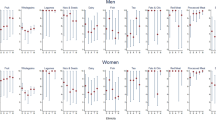Abstract
Objective: To assess socio-economic differences in nutrient intake, giving particular consideration to the influence of reporting bias.
Design: Cross-sectional study. Three methods of data analysis (inclusion of all subjects, exclusion of low energy reporters, and regression-based energy adjustment) were evaluated against biomarkers of fatty acid and antioxidant intakes.
Setting: London-based Civil Servants.
Subjects: Age and employment grade stratified random sub-sample of 459 men and 406 women aged 39–61 y who completed 7 d diet diaries at Phase 3 follow-up (1991–93) of the Whitehall II Study.
Dietary measures: Mean daily intakes by employment grade (6 levels) of dietary energy, total fat, saturated fatty acids, polyunsaturated fatty acids (PUFA), linoleic acid, carbohydrate excluding fibre, dietary fibre, protein, alcohol, vitamin C, vitamin E, carotenes, potassium and calcium. Biomarkers: serum cholesterol ester fatty acids (CEFA), total cholesterol, plasma α-tocopherol and β-carotene.
Results: Low energy reporting (LER), defined as a reported energy intake below 1.2 times calculated basal metabolic rate, was strongly associated with employment grade (top grade: men 17.3%, women 19.3%, bottom grade: men 45.7%, women 49.2% trend P<0.0001 both sexes). This association is only to a small extent accounted for by the relative weight distribution across grades. The direct associations with grade—high status, high intakes—of total fat, saturated and polyunsaturated fatty acids seen in the results overall were greatly reduced or abolished when LER were excluded or when energy adjustment was used. Direct associations between grade and intakes of vitamin C and potassium in both sexes were evident regardless of data presentation method. Spearman correlations between biomarkers and reported intakes, for example CEFA and dietary linoleate (men 0.46, women 0.61), plasma β-carotene/cholesterol ratio and dietary carotenes (men 0.16, women 0.21) together with theoretical considerations indicate that energy adjustment may be the preferred method for reducing the influence of reporting bias.
Conclusions: Low energy reporting is a major source of bias in dietary surveys and its prevalence shows a marked inverse association with socio-economic status. The energy adjustment method provides an approach which reduces this bias without exclusion of low energy reporters. Intakes of micronutrients including vitamin C, rather than fatty acids, showed associations with socio-economic status consistent with a dietary explanation for social inequalities in cardiovascular disease.
Sponsorship: Ministry of Agriculture, Fisheries and Food and DH/MRC Nutrition Programme (SPG 9324537).
This is a preview of subscription content, access via your institution
Access options
Subscribe to this journal
Receive 12 print issues and online access
$259.00 per year
only $21.58 per issue
Buy this article
- Purchase on Springer Link
- Instant access to full article PDF
Prices may be subject to local taxes which are calculated during checkout
Similar content being viewed by others
Author information
Authors and Affiliations
Rights and permissions
About this article
Cite this article
Stallone, D., Brunner, E., Bingham, S. et al. Dietary assessment in Whitehall II: The influence of reporting bias on apparent socioeconomic variation in nutrient intakes. Eur J Clin Nutr 51, 815–825 (1997). https://doi.org/10.1038/sj.ejcn.1600491
Received:
Revised:
Accepted:
Issue Date:
DOI: https://doi.org/10.1038/sj.ejcn.1600491
Keywords
This article is cited by
-
Are dietary inequalities among Australian adults changing? a nationally representative analysis of dietary change according to socioeconomic position between 1995 and 2011–13
International Journal of Behavioral Nutrition and Physical Activity (2018)
-
Re-evaluation of the associations of egg intake with serum total cholesterol and cause-specific and total mortality in Japanese women
European Journal of Clinical Nutrition (2018)
-
Sugar intake from sweet food and beverages, common mental disorder and depression: prospective findings from the Whitehall II study
Scientific Reports (2017)
-
Relative validation of the KiGGS Food Frequency Questionnaire among adolescents in Germany
Nutrition Journal (2011)
-
Measuring dietary intake in children and adolescents in the context of overweight and obesity
International Journal of Obesity (2010)



